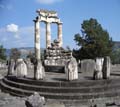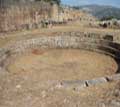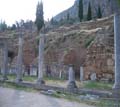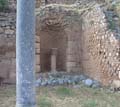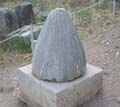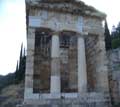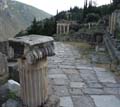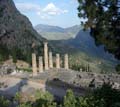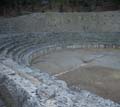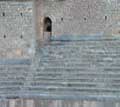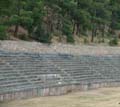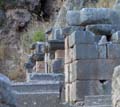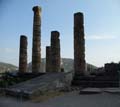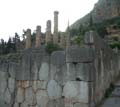
ADMINISTRATIVE AREA OF PHOCIS
A. HISTORY OF THE SANCTUARYDelphi was a city of ancient Phocis built on the SW side of Parnassus, at the base of two large rocks, the Phaedriades. From the archaeological research it is concluded that they were inhabited for the first time in 1400 BC, during the Mycenaean period. Evidence of the first Mycenaean settlement, which was located higher than the sanctuary of Apollo, where today are the ruins of the temple of Athena Pronea, are abundant figurines of a standing female figure, which is probably identified with the goddess Earth. Since for a period of 500-600 years the settlement was destroyed and abandoned, during the geometric period, between the 11th and 9th centuries BC, the cult of the god Apollo was established in Delphi, as evidenced by the bronze votives of male figures dedicated by the faithful. In the two following centuries, the holy mosque with its precincts constantly increased in size, the votives multiply and become more and more rich: typical votives of the time are bronze tripods. This is indeed how the philological sources are confirmed. The tripus now becomes a symbol of the sanctuary and the Pythia sits on it and gives oracles.
RISE
Holy Wars - Amphictyonia - Persian Wars
The attempt of the neighboring city of Chrysas to intervene in the affairs of the sanctuary, led in 590 BC. in the First Holy War. Chrysa is defeated and destroyed by the allies of Amphictyonia, since then the Chrysaion Pedion, a rich olive grove, is dedicated to Apollo. Amphictyonia was a religious union, a federation mainly of neighboring states, its members were twelve nations and its purpose was to supervise the festivals and sacrifices performed in honor of Apollo. Two Hieromnemones from each of its members are its representatives and together with the Pylagores manage the affairs of the god and the sanctuary. In time, the Delphic Amphictyonia acquired decisive responsibilities in the administration of the sanctuary of Apollo.
From the 6th to the 4th century BC is the period of the great prosperity of the sanctuary of Delphi. Crowds of pilgrims flocked from all over the ancient world to seek the god's advice and oracle on any serious decision or action of theirs. After the end of the Persian wars brilliant vows are dedicated to Delphi, both by the victorious Greeks and by the allies of Persians.
DISASTERS - BARBARIAN INVASIONS - DECLINE
After the Fourth Holy War, in 279 BC, tens of thousands of barbarian Gauls under Brennus invaded Greece and reached the sanctuary of Delphi, whose riches they were eyeing.
The Greeks resisted strongly, putting to flight those barbarians who escaped the battle and the falling rocks from Parnassos. Since then, the Salvation Festivals are celebrated annually in honor of Sotiros Dios and Apollo.
In 86 BC the Romans, under Sulla, besiege Athens and in order to secure resources for the continuation of the siege, they demand that the precious offerings of the sanctuary be given to them, which Amphictyonia is forced to do.
In 83 BC Thracian Maidens loot the sanctuary, set fire to the temple of Apollo and it is said that then the sacred fire that had been burning there for centuries was extinguished.
In 67 AD Nero seizes 500 bronze statues and sends them to Rome.
Among the Roman emperors, Trajan was favorable, but especially Hadrian, during whose time the wealthy Athenian sophist Herodes Atticus did many favors to the sanctuary and spent money on the construction of the stadium's stone seats. Also favorably situated were Marcus Aurelius and Septimius Severus.
Constantine the Great (306-337 AD) seizes votives to adorn Constantinople. Among them the three coiled copper snakes of the tripod of Plataea where all the names of the Hellenic cities that had taken part in the crucial battle were written. The national religion dies out, and the Greek cities subject to the Romans no longer ask for oracles, nor send vows. There are no more believers, no more pilgrims.
Well-known is the oracle that Pythia is rumored to have given to Emperor Julian 360-363 AD.) Theodosius the Great 392 AD. prohibits by legislative decree ancient worship and games. From the 5th century AD on the ruins of the sanctuary of Apollo the village of Delphi is built which remained in the same position until 1892 when the excavations began.
B. WORSHIP
Apollo, the god of the Sun, music and divination, seems to have succeeded the worship of older gods (Earth, Themis, the Titan Phoebe) in the sanctuary of Delphi.
Although his name is not mentioned on any Linear B tablet, he has a clear prehistoric-Creto-Mycenaean background: many attributes pertaining to lesser deities of that time were later merged into the form of Apollo. For example, PaiaFon-Paiion: the divine chant that appeases the divine wrath that eventually becomes an epithet and attribute of Apollo.
After all, the tradition of the founding and manning of the Delphi oracle reveal its Creto-Mycenaean roots: Apollo, transformed into a dolphin, managed to lure Cretan merchants with their ships to Crisa and from there he showed them the location of Delphi transformed into a bright star . These were the first priests of the temple and the oracle.
Apollo is also said to have slain the chthonic dragon Python, who was the guardian of the Earth sanctuary at Delphi. After the murder, he went to Tempi to be cleansed of the miasma. He returns with the laurel branch, the seed of new life. In the representation of the murder according to the Septerias, the killing of Python is the death and rebirth of the god himself, who appears with a chthonia (Python, Apollo in the Hyperboreans) and a vigorous hypostasis (the god after purification).
The god's cleansing utensils were the laurel (its touch was enough), the arrows (and death as cleansing of the miasma) and the song. Thus, Apollo is a pure but also fertile, procreative god of nature.
Apollo rules happiness and unhappiness and knows ways to prevent the latter. He protects, expresses and carries out the will of Zeus, who arranged the destinies of the world. This infallible divine will was imposed on mortals as a direction of action, leaving room for choice. So the answers of the oracle god were open to many interpretations: "the anax in Delphi neither says, nor hides, but means".
The god knower of universal harmony, the protector of cosmic and human law, the guarantor of the morality of the law, is the triple attribute of Apollo and is symbolized in the depiction:
of the bow (the archer god as the punisher of those who commit evil, intervenes in order to guide events according to the divine will. He punishes those who violate the divine will: Niobe, Marsyas, Titius) of the guitar (musician, the song an expression of reciprocating harmony, of the harmony of opposites. Companions of the divine musician are the nine Muses, the protectors of all knowledge and will that ensures the harmony of individual and social life) of the tripod (divining quality, interpreter, protector of native customs and the unwritten law, leader: for the building a colony the metropolis always consulted the oracle of Delphi Patroos: the origin of the laws of a city went from the Apollonian spirit: the laws of Gortynos are published on the wall and steps of his temple,in Athens, the city records are kept inside the temple of Apollo Patroos in the ancient market.)
Other attributes of Apollo:
Medicine: can send devastating plagues as well as prevent them. His arrows could be destructive, embodying the misery they could bring upon mortals, or beneficent, driving away darkness and chthonic forces (Python). Asclepius is said to have been the son of Apollo.
Also in the face of Apollo is embodied a bucolic character (Nomios, Poimnios, Kourotrophos), a martial quality (Boidromios, Strataios, Laossos, Ecargios. ) Omphalos: according to the myth, Delphi was the center - the Omphalos of the earth. Perhaps the sculptural representation of Omphalos is also a non-figurative - symbolic representation of the god.
The Pythia was the priestess of the oracle (a venerable woman from Delphi) who uttered the oracles which were then interpreted by the priests of Apollo.
Pilgrims who came to receive oracles were called theopropos who followed a certain formality: first they bathed in the threads of the Castilian spring, paid an obligatory contribution, the pelanon, then sacrificed a goat after first sprinkling it with cold water. If the goat bleated, it meant that the day was good. Immediately after the sacrifice, the Pythia would enter the temple - since she herself had previously been cleansed with the water of Castalia - and proceed alone to the sanctuary from where, mounted on the sacred tripod next to Omphalos, she would listen to the question and give her oracles.
Behind the ruins of the Parliament is the spring guarded by Python, the huge Dragon killed by Apollo. There was the Septirion where every eight years a sacred drama was performed, a reenactment of the killing of Python.
Sotiria: celebrated annually in honor of Zeus Savior and Apollo.
Pythias: Originally they were musical competitions, but from 582 BC. athletic and equestrian competitions are also added and are held every four years.
C. MOST IMPORTANT MONUMENTS:
In ancient times, the entire sanctuary was surrounded by a strong wall with a majestic gate to the SE which was also the entrance to the sanctuary. Temple of Apollo It is located in the center of the sanctuary and the current ruins belong to various building phases. there was the cult statue of the god and from the shelter Pythia gave the oracles. On the walls of the pronaus were engraved quotations from the Seven Wise Men: Gnothi sauton, Miden agan and the mysteriously significant E. The Theatron, whose colon includes 35 semicircular rows of seats was used for the feasts of the sanctuary and for the dramatic and lyrical contests.
The Stadium was built in the 5th BC. h. and benches were added in the 2nd AD. h. expenses of Herod Atticus. The Pythias, nudist (athletic) and musical competitions, were held there every four years. They started on the 6th of Voukatio (August-September) on Apollo's birthday. Equestrian competitions took place on the plain of Crisa.
Athenian treasure Doric temple, restored, built in 490/489 with the tithe of the spoils of the battle of Marathon as a tribute to Apollo but also to house tributes of the city of Athens. On the pediments as well as on the metopes the labors of Herakles and Theseus, on the metopes of the facade Amazonomachia. On the walls are engraved inscriptions of significant historical importance and two hymns to Apollo with the musical symbols of their ancient melody marked.
The Treasury of Sifnia was the most beautiful and luxurious building according to the testimony of Pausanias. Today only its base is preserved. In front of it were two statues, Caryatids. The frieze that adorned it depicted on the facade the judgment of Paris, fragments of which are preserved. Also episodes of the Trojan War, Council of the Gods and Giant Battle. On the pediment of the upper side, Apollo and Herakles are depicted holding the prophetic tripod.
The Sanctuary of Athena Pronaia consisting of many altars and the temple of the goddess. The first temple was built in the 7th century BC. and in the same place, after the destruction of the original, it was built in 500 BC. new church, Porino, Doric style, pavilion. West of the temple there are ruins of two treasures and west of the treasures a round building, the Dome. It is a masterpiece of ancient architecture built in 380 BC. about. It is of the Doric style, externally it had 20 columns on which the thrigos rested. Triglyphs and metopes were present both on the trigo and on the circular wall of the nave from the outside, while on the inside there were 10 Corinthian semi-columns. The building had some special significance, unknown today.
Editor: Fotini Anastasopoulou










